Bachelor of Nursing Assignment: Pregnancy Complications and Treatments
VerifiedAdded on 2022/09/28
|7
|2162
|21
Homework Assignment
AI Summary
This nursing assignment addresses several key topics in maternal and infant health. It begins with an analysis of infant skin structure, highlighting differences compared to adult skin and strategies to prevent heat loss in infants. The assignment then delves into gestational diabetes, exploring carbohydrate processing, the impact of placental hormones, and management strategies to mitigate potential effects on both mother and fetus. Fracture recovery during pregnancy is examined, including the healing process, the impact of hormonal changes, and potential effects on the fetus. Finally, the assignment discusses hyperemesis gravidarum, its effects on the mother and fetus, including dehydration, electrolyte imbalances, and potential complications such as premature labor and fetal malnutrition. The document offers insights into nursing care and the complexities of these conditions during pregnancy.

Bachelor of nursing
Student name
Student ID:
1
Student name
Student ID:
1
Paraphrase This Document
Need a fresh take? Get an instant paraphrase of this document with our AI Paraphraser
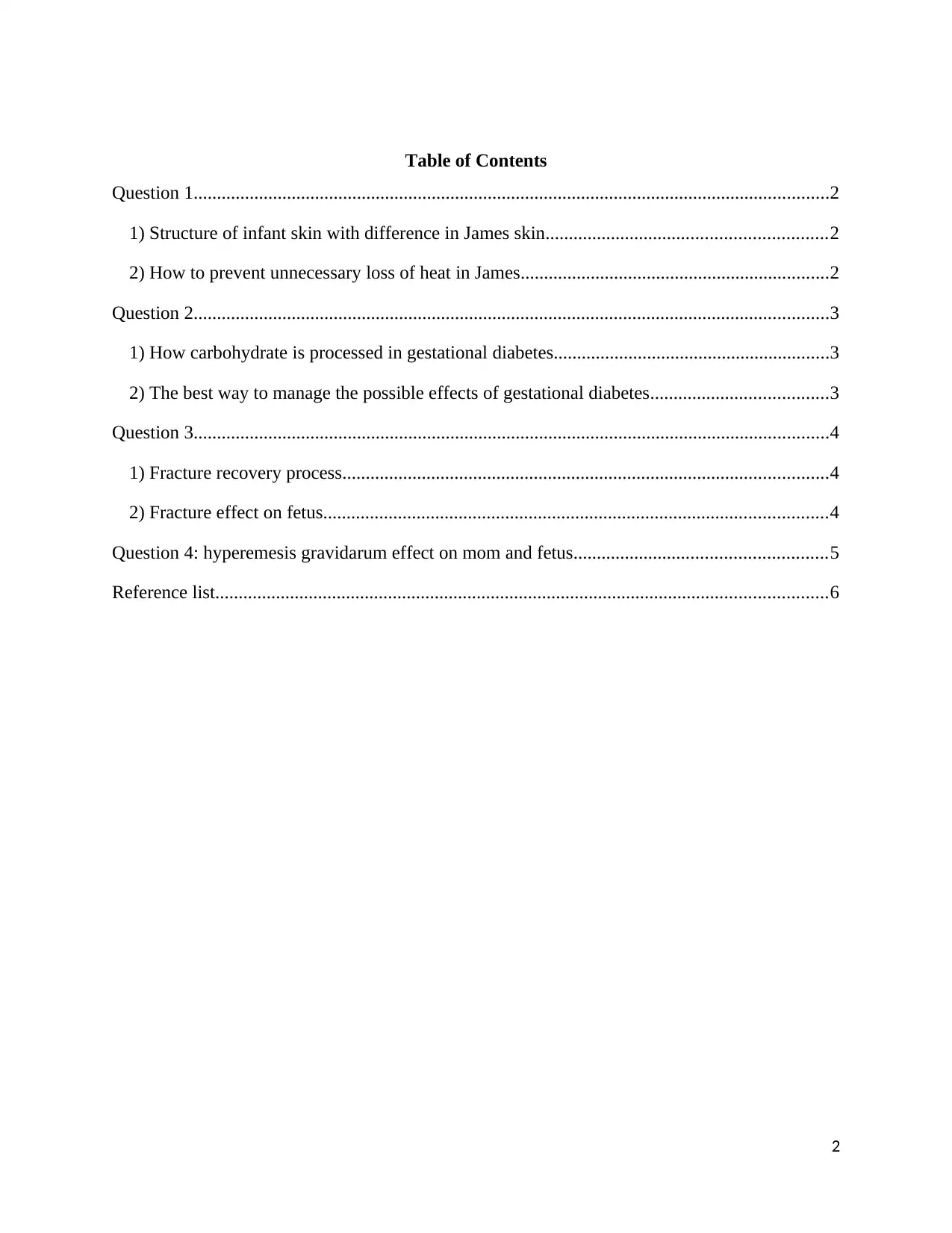
Table of Contents
Question 1........................................................................................................................................2
1) Structure of infant skin with difference in James skin............................................................2
2) How to prevent unnecessary loss of heat in James..................................................................2
Question 2........................................................................................................................................3
1) How carbohydrate is processed in gestational diabetes...........................................................3
2) The best way to manage the possible effects of gestational diabetes......................................3
Question 3........................................................................................................................................4
1) Fracture recovery process........................................................................................................4
2) Fracture effect on fetus............................................................................................................4
Question 4: hyperemesis gravidarum effect on mom and fetus......................................................5
Reference list...................................................................................................................................6
2
Question 1........................................................................................................................................2
1) Structure of infant skin with difference in James skin............................................................2
2) How to prevent unnecessary loss of heat in James..................................................................2
Question 2........................................................................................................................................3
1) How carbohydrate is processed in gestational diabetes...........................................................3
2) The best way to manage the possible effects of gestational diabetes......................................3
Question 3........................................................................................................................................4
1) Fracture recovery process........................................................................................................4
2) Fracture effect on fetus............................................................................................................4
Question 4: hyperemesis gravidarum effect on mom and fetus......................................................5
Reference list...................................................................................................................................6
2
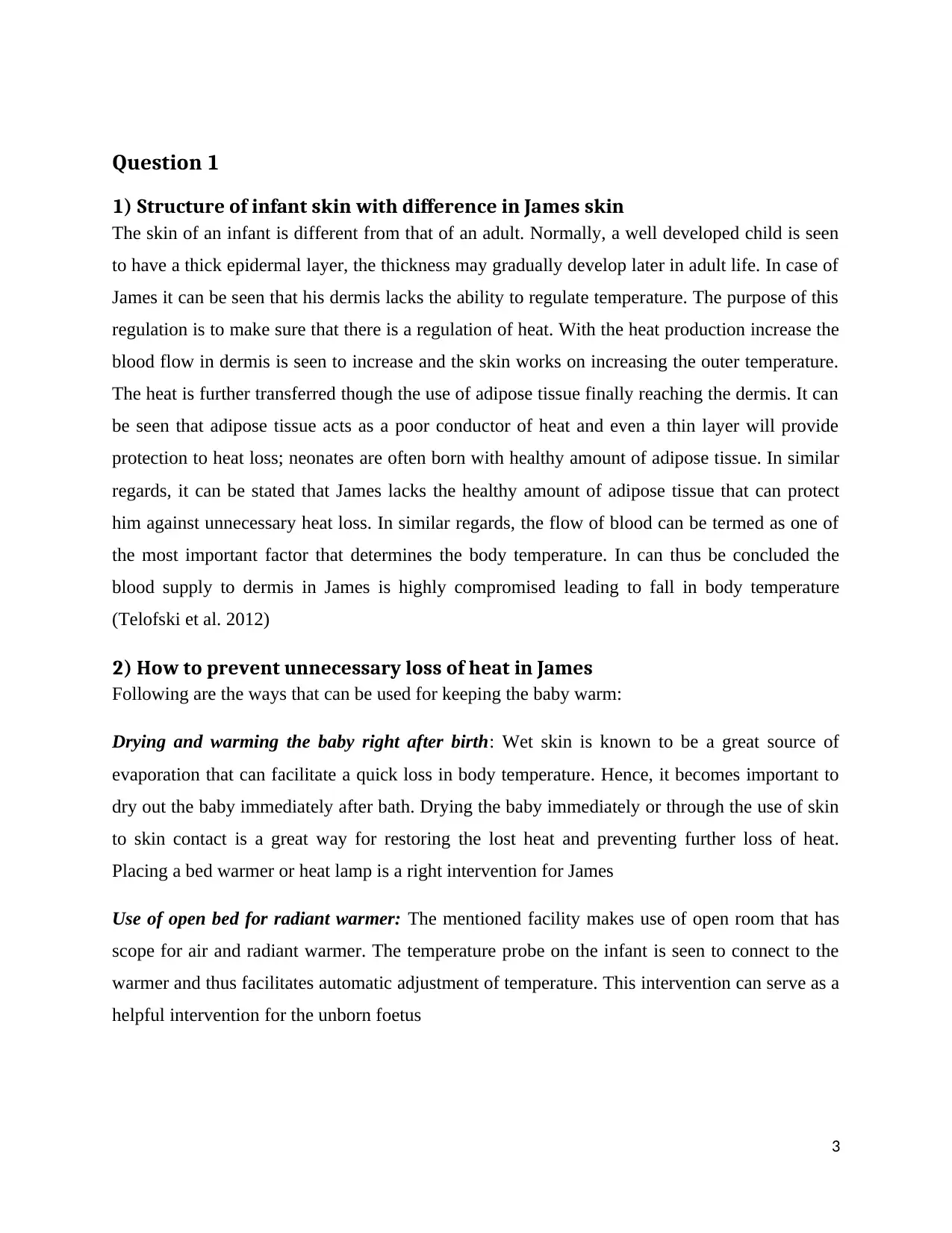
Question 1
1) Structure of infant skin with difference in James skin
The skin of an infant is different from that of an adult. Normally, a well developed child is seen
to have a thick epidermal layer, the thickness may gradually develop later in adult life. In case of
James it can be seen that his dermis lacks the ability to regulate temperature. The purpose of this
regulation is to make sure that there is a regulation of heat. With the heat production increase the
blood flow in dermis is seen to increase and the skin works on increasing the outer temperature.
The heat is further transferred though the use of adipose tissue finally reaching the dermis. It can
be seen that adipose tissue acts as a poor conductor of heat and even a thin layer will provide
protection to heat loss; neonates are often born with healthy amount of adipose tissue. In similar
regards, it can be stated that James lacks the healthy amount of adipose tissue that can protect
him against unnecessary heat loss. In similar regards, the flow of blood can be termed as one of
the most important factor that determines the body temperature. In can thus be concluded the
blood supply to dermis in James is highly compromised leading to fall in body temperature
(Telofski et al. 2012)
2) How to prevent unnecessary loss of heat in James
Following are the ways that can be used for keeping the baby warm:
Drying and warming the baby right after birth: Wet skin is known to be a great source of
evaporation that can facilitate a quick loss in body temperature. Hence, it becomes important to
dry out the baby immediately after bath. Drying the baby immediately or through the use of skin
to skin contact is a great way for restoring the lost heat and preventing further loss of heat.
Placing a bed warmer or heat lamp is a right intervention for James
Use of open bed for radiant warmer: The mentioned facility makes use of open room that has
scope for air and radiant warmer. The temperature probe on the infant is seen to connect to the
warmer and thus facilitates automatic adjustment of temperature. This intervention can serve as a
helpful intervention for the unborn foetus
3
1) Structure of infant skin with difference in James skin
The skin of an infant is different from that of an adult. Normally, a well developed child is seen
to have a thick epidermal layer, the thickness may gradually develop later in adult life. In case of
James it can be seen that his dermis lacks the ability to regulate temperature. The purpose of this
regulation is to make sure that there is a regulation of heat. With the heat production increase the
blood flow in dermis is seen to increase and the skin works on increasing the outer temperature.
The heat is further transferred though the use of adipose tissue finally reaching the dermis. It can
be seen that adipose tissue acts as a poor conductor of heat and even a thin layer will provide
protection to heat loss; neonates are often born with healthy amount of adipose tissue. In similar
regards, it can be stated that James lacks the healthy amount of adipose tissue that can protect
him against unnecessary heat loss. In similar regards, the flow of blood can be termed as one of
the most important factor that determines the body temperature. In can thus be concluded the
blood supply to dermis in James is highly compromised leading to fall in body temperature
(Telofski et al. 2012)
2) How to prevent unnecessary loss of heat in James
Following are the ways that can be used for keeping the baby warm:
Drying and warming the baby right after birth: Wet skin is known to be a great source of
evaporation that can facilitate a quick loss in body temperature. Hence, it becomes important to
dry out the baby immediately after bath. Drying the baby immediately or through the use of skin
to skin contact is a great way for restoring the lost heat and preventing further loss of heat.
Placing a bed warmer or heat lamp is a right intervention for James
Use of open bed for radiant warmer: The mentioned facility makes use of open room that has
scope for air and radiant warmer. The temperature probe on the infant is seen to connect to the
warmer and thus facilitates automatic adjustment of temperature. This intervention can serve as a
helpful intervention for the unborn foetus
3
⊘ This is a preview!⊘
Do you want full access?
Subscribe today to unlock all pages.

Trusted by 1+ million students worldwide
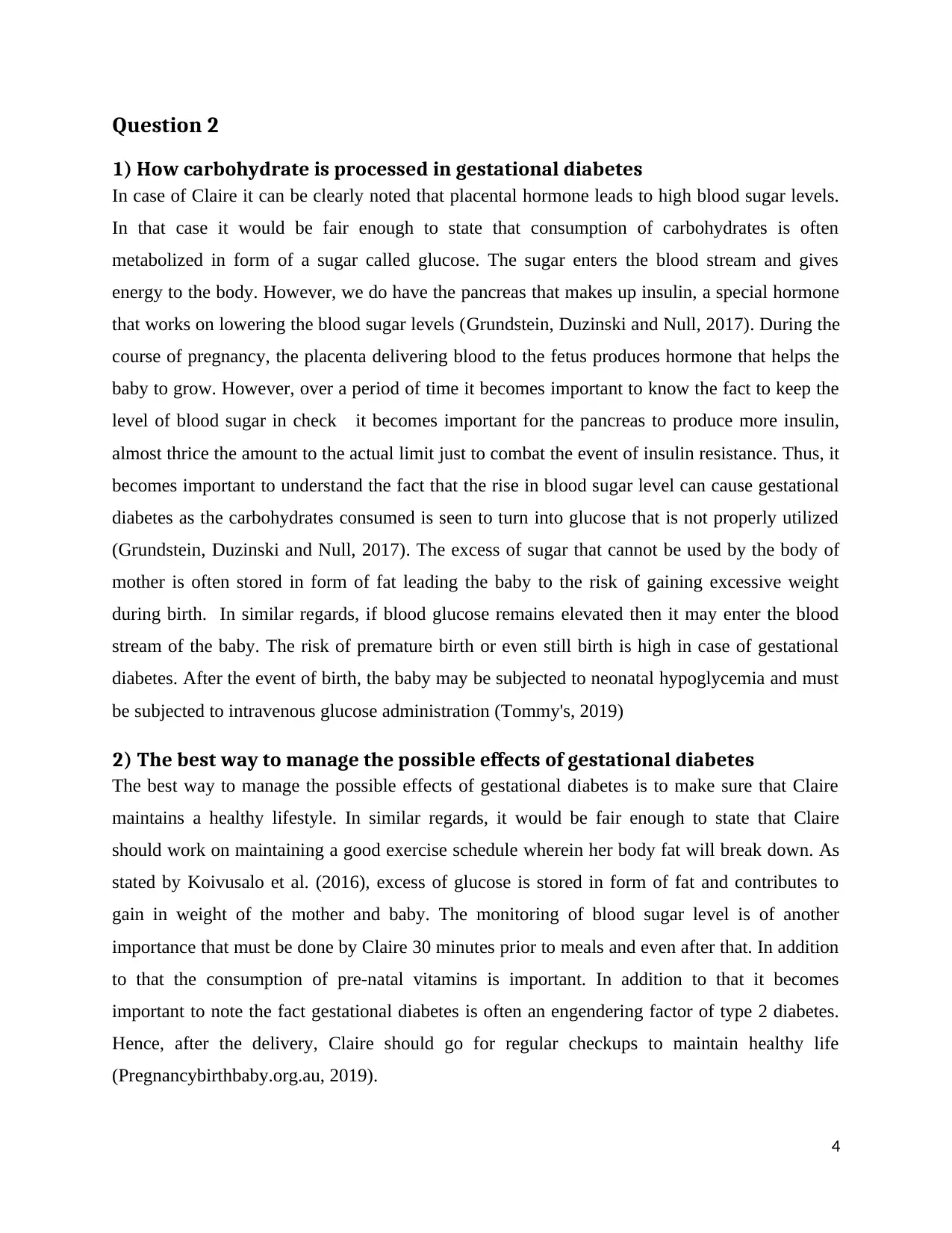
Question 2
1) How carbohydrate is processed in gestational diabetes
In case of Claire it can be clearly noted that placental hormone leads to high blood sugar levels.
In that case it would be fair enough to state that consumption of carbohydrates is often
metabolized in form of a sugar called glucose. The sugar enters the blood stream and gives
energy to the body. However, we do have the pancreas that makes up insulin, a special hormone
that works on lowering the blood sugar levels (Grundstein, Duzinski and Null, 2017). During the
course of pregnancy, the placenta delivering blood to the fetus produces hormone that helps the
baby to grow. However, over a period of time it becomes important to know the fact to keep the
level of blood sugar in check it becomes important for the pancreas to produce more insulin,
almost thrice the amount to the actual limit just to combat the event of insulin resistance. Thus, it
becomes important to understand the fact that the rise in blood sugar level can cause gestational
diabetes as the carbohydrates consumed is seen to turn into glucose that is not properly utilized
(Grundstein, Duzinski and Null, 2017). The excess of sugar that cannot be used by the body of
mother is often stored in form of fat leading the baby to the risk of gaining excessive weight
during birth. In similar regards, if blood glucose remains elevated then it may enter the blood
stream of the baby. The risk of premature birth or even still birth is high in case of gestational
diabetes. After the event of birth, the baby may be subjected to neonatal hypoglycemia and must
be subjected to intravenous glucose administration (Tommy's, 2019)
2) The best way to manage the possible effects of gestational diabetes
The best way to manage the possible effects of gestational diabetes is to make sure that Claire
maintains a healthy lifestyle. In similar regards, it would be fair enough to state that Claire
should work on maintaining a good exercise schedule wherein her body fat will break down. As
stated by Koivusalo et al. (2016), excess of glucose is stored in form of fat and contributes to
gain in weight of the mother and baby. The monitoring of blood sugar level is of another
importance that must be done by Claire 30 minutes prior to meals and even after that. In addition
to that the consumption of pre-natal vitamins is important. In addition to that it becomes
important to note the fact gestational diabetes is often an engendering factor of type 2 diabetes.
Hence, after the delivery, Claire should go for regular checkups to maintain healthy life
(Pregnancybirthbaby.org.au, 2019).
4
1) How carbohydrate is processed in gestational diabetes
In case of Claire it can be clearly noted that placental hormone leads to high blood sugar levels.
In that case it would be fair enough to state that consumption of carbohydrates is often
metabolized in form of a sugar called glucose. The sugar enters the blood stream and gives
energy to the body. However, we do have the pancreas that makes up insulin, a special hormone
that works on lowering the blood sugar levels (Grundstein, Duzinski and Null, 2017). During the
course of pregnancy, the placenta delivering blood to the fetus produces hormone that helps the
baby to grow. However, over a period of time it becomes important to know the fact to keep the
level of blood sugar in check it becomes important for the pancreas to produce more insulin,
almost thrice the amount to the actual limit just to combat the event of insulin resistance. Thus, it
becomes important to understand the fact that the rise in blood sugar level can cause gestational
diabetes as the carbohydrates consumed is seen to turn into glucose that is not properly utilized
(Grundstein, Duzinski and Null, 2017). The excess of sugar that cannot be used by the body of
mother is often stored in form of fat leading the baby to the risk of gaining excessive weight
during birth. In similar regards, if blood glucose remains elevated then it may enter the blood
stream of the baby. The risk of premature birth or even still birth is high in case of gestational
diabetes. After the event of birth, the baby may be subjected to neonatal hypoglycemia and must
be subjected to intravenous glucose administration (Tommy's, 2019)
2) The best way to manage the possible effects of gestational diabetes
The best way to manage the possible effects of gestational diabetes is to make sure that Claire
maintains a healthy lifestyle. In similar regards, it would be fair enough to state that Claire
should work on maintaining a good exercise schedule wherein her body fat will break down. As
stated by Koivusalo et al. (2016), excess of glucose is stored in form of fat and contributes to
gain in weight of the mother and baby. The monitoring of blood sugar level is of another
importance that must be done by Claire 30 minutes prior to meals and even after that. In addition
to that the consumption of pre-natal vitamins is important. In addition to that it becomes
important to note the fact gestational diabetes is often an engendering factor of type 2 diabetes.
Hence, after the delivery, Claire should go for regular checkups to maintain healthy life
(Pregnancybirthbaby.org.au, 2019).
4
Paraphrase This Document
Need a fresh take? Get an instant paraphrase of this document with our AI Paraphraser
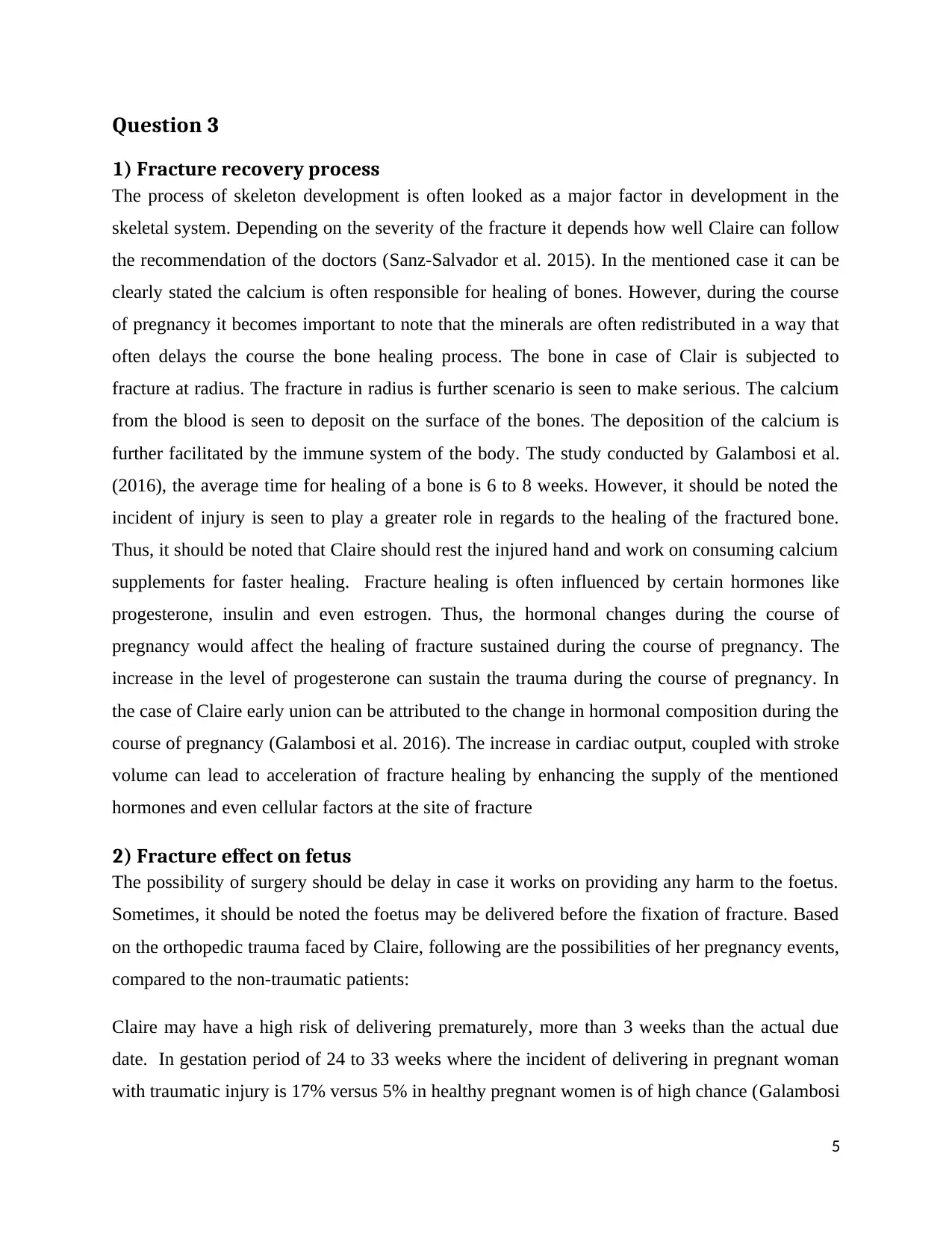
Question 3
1) Fracture recovery process
The process of skeleton development is often looked as a major factor in development in the
skeletal system. Depending on the severity of the fracture it depends how well Claire can follow
the recommendation of the doctors (Sanz-Salvador et al. 2015). In the mentioned case it can be
clearly stated the calcium is often responsible for healing of bones. However, during the course
of pregnancy it becomes important to note that the minerals are often redistributed in a way that
often delays the course the bone healing process. The bone in case of Clair is subjected to
fracture at radius. The fracture in radius is further scenario is seen to make serious. The calcium
from the blood is seen to deposit on the surface of the bones. The deposition of the calcium is
further facilitated by the immune system of the body. The study conducted by Galambosi et al.
(2016), the average time for healing of a bone is 6 to 8 weeks. However, it should be noted the
incident of injury is seen to play a greater role in regards to the healing of the fractured bone.
Thus, it should be noted that Claire should rest the injured hand and work on consuming calcium
supplements for faster healing. Fracture healing is often influenced by certain hormones like
progesterone, insulin and even estrogen. Thus, the hormonal changes during the course of
pregnancy would affect the healing of fracture sustained during the course of pregnancy. The
increase in the level of progesterone can sustain the trauma during the course of pregnancy. In
the case of Claire early union can be attributed to the change in hormonal composition during the
course of pregnancy (Galambosi et al. 2016). The increase in cardiac output, coupled with stroke
volume can lead to acceleration of fracture healing by enhancing the supply of the mentioned
hormones and even cellular factors at the site of fracture
2) Fracture effect on fetus
The possibility of surgery should be delay in case it works on providing any harm to the foetus.
Sometimes, it should be noted the foetus may be delivered before the fixation of fracture. Based
on the orthopedic trauma faced by Claire, following are the possibilities of her pregnancy events,
compared to the non-traumatic patients:
Claire may have a high risk of delivering prematurely, more than 3 weeks than the actual due
date. In gestation period of 24 to 33 weeks where the incident of delivering in pregnant woman
with traumatic injury is 17% versus 5% in healthy pregnant women is of high chance (Galambosi
5
1) Fracture recovery process
The process of skeleton development is often looked as a major factor in development in the
skeletal system. Depending on the severity of the fracture it depends how well Claire can follow
the recommendation of the doctors (Sanz-Salvador et al. 2015). In the mentioned case it can be
clearly stated the calcium is often responsible for healing of bones. However, during the course
of pregnancy it becomes important to note that the minerals are often redistributed in a way that
often delays the course the bone healing process. The bone in case of Clair is subjected to
fracture at radius. The fracture in radius is further scenario is seen to make serious. The calcium
from the blood is seen to deposit on the surface of the bones. The deposition of the calcium is
further facilitated by the immune system of the body. The study conducted by Galambosi et al.
(2016), the average time for healing of a bone is 6 to 8 weeks. However, it should be noted the
incident of injury is seen to play a greater role in regards to the healing of the fractured bone.
Thus, it should be noted that Claire should rest the injured hand and work on consuming calcium
supplements for faster healing. Fracture healing is often influenced by certain hormones like
progesterone, insulin and even estrogen. Thus, the hormonal changes during the course of
pregnancy would affect the healing of fracture sustained during the course of pregnancy. The
increase in the level of progesterone can sustain the trauma during the course of pregnancy. In
the case of Claire early union can be attributed to the change in hormonal composition during the
course of pregnancy (Galambosi et al. 2016). The increase in cardiac output, coupled with stroke
volume can lead to acceleration of fracture healing by enhancing the supply of the mentioned
hormones and even cellular factors at the site of fracture
2) Fracture effect on fetus
The possibility of surgery should be delay in case it works on providing any harm to the foetus.
Sometimes, it should be noted the foetus may be delivered before the fixation of fracture. Based
on the orthopedic trauma faced by Claire, following are the possibilities of her pregnancy events,
compared to the non-traumatic patients:
Claire may have a high risk of delivering prematurely, more than 3 weeks than the actual due
date. In gestation period of 24 to 33 weeks where the incident of delivering in pregnant woman
with traumatic injury is 17% versus 5% in healthy pregnant women is of high chance (Galambosi
5
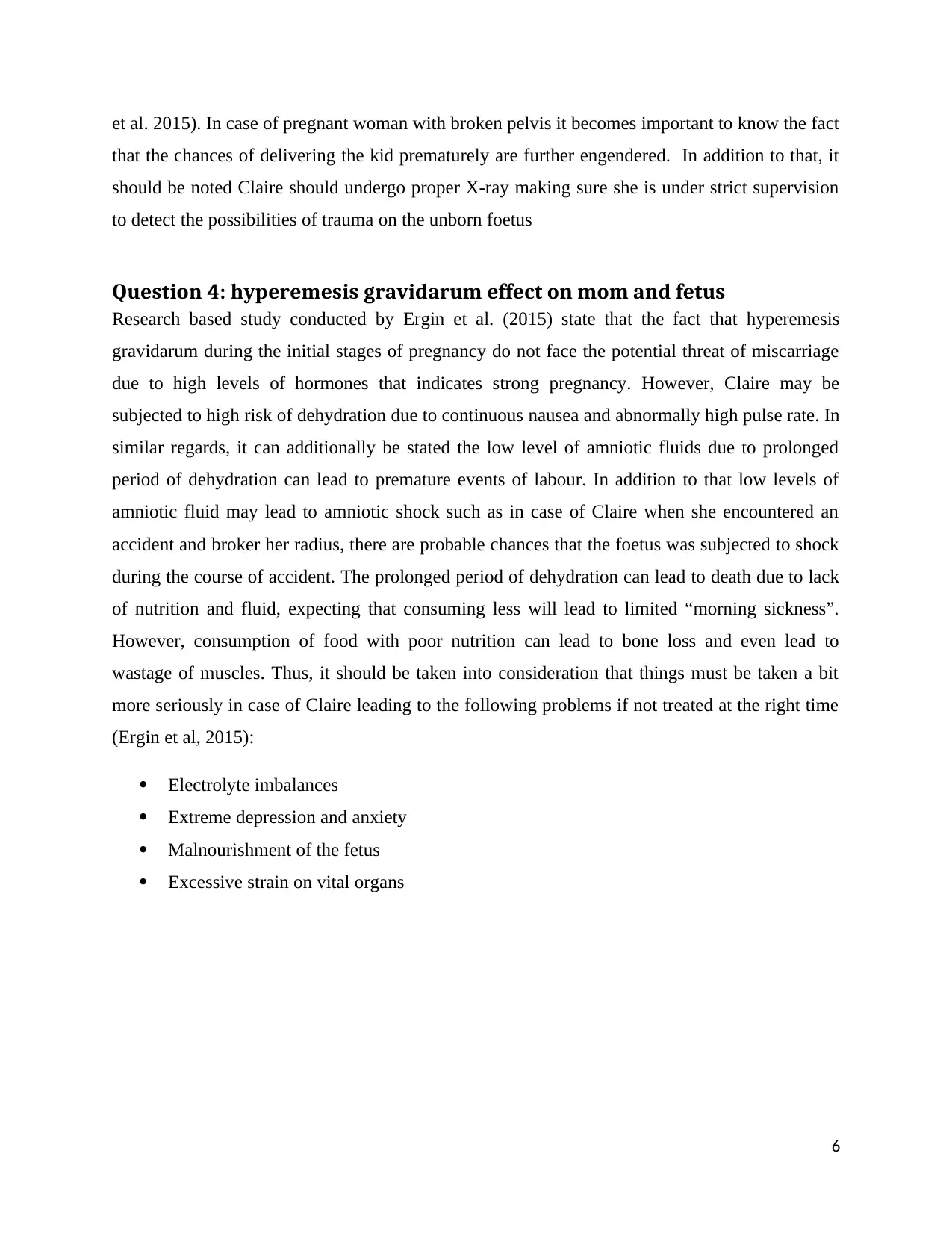
et al. 2015). In case of pregnant woman with broken pelvis it becomes important to know the fact
that the chances of delivering the kid prematurely are further engendered. In addition to that, it
should be noted Claire should undergo proper X-ray making sure she is under strict supervision
to detect the possibilities of trauma on the unborn foetus
Question 4: hyperemesis gravidarum effect on mom and fetus
Research based study conducted by Ergin et al. (2015) state that the fact that hyperemesis
gravidarum during the initial stages of pregnancy do not face the potential threat of miscarriage
due to high levels of hormones that indicates strong pregnancy. However, Claire may be
subjected to high risk of dehydration due to continuous nausea and abnormally high pulse rate. In
similar regards, it can additionally be stated the low level of amniotic fluids due to prolonged
period of dehydration can lead to premature events of labour. In addition to that low levels of
amniotic fluid may lead to amniotic shock such as in case of Claire when she encountered an
accident and broker her radius, there are probable chances that the foetus was subjected to shock
during the course of accident. The prolonged period of dehydration can lead to death due to lack
of nutrition and fluid, expecting that consuming less will lead to limited “morning sickness”.
However, consumption of food with poor nutrition can lead to bone loss and even lead to
wastage of muscles. Thus, it should be taken into consideration that things must be taken a bit
more seriously in case of Claire leading to the following problems if not treated at the right time
(Ergin et al, 2015):
Electrolyte imbalances
Extreme depression and anxiety
Malnourishment of the fetus
Excessive strain on vital organs
6
that the chances of delivering the kid prematurely are further engendered. In addition to that, it
should be noted Claire should undergo proper X-ray making sure she is under strict supervision
to detect the possibilities of trauma on the unborn foetus
Question 4: hyperemesis gravidarum effect on mom and fetus
Research based study conducted by Ergin et al. (2015) state that the fact that hyperemesis
gravidarum during the initial stages of pregnancy do not face the potential threat of miscarriage
due to high levels of hormones that indicates strong pregnancy. However, Claire may be
subjected to high risk of dehydration due to continuous nausea and abnormally high pulse rate. In
similar regards, it can additionally be stated the low level of amniotic fluids due to prolonged
period of dehydration can lead to premature events of labour. In addition to that low levels of
amniotic fluid may lead to amniotic shock such as in case of Claire when she encountered an
accident and broker her radius, there are probable chances that the foetus was subjected to shock
during the course of accident. The prolonged period of dehydration can lead to death due to lack
of nutrition and fluid, expecting that consuming less will lead to limited “morning sickness”.
However, consumption of food with poor nutrition can lead to bone loss and even lead to
wastage of muscles. Thus, it should be taken into consideration that things must be taken a bit
more seriously in case of Claire leading to the following problems if not treated at the right time
(Ergin et al, 2015):
Electrolyte imbalances
Extreme depression and anxiety
Malnourishment of the fetus
Excessive strain on vital organs
6
⊘ This is a preview!⊘
Do you want full access?
Subscribe today to unlock all pages.

Trusted by 1+ million students worldwide
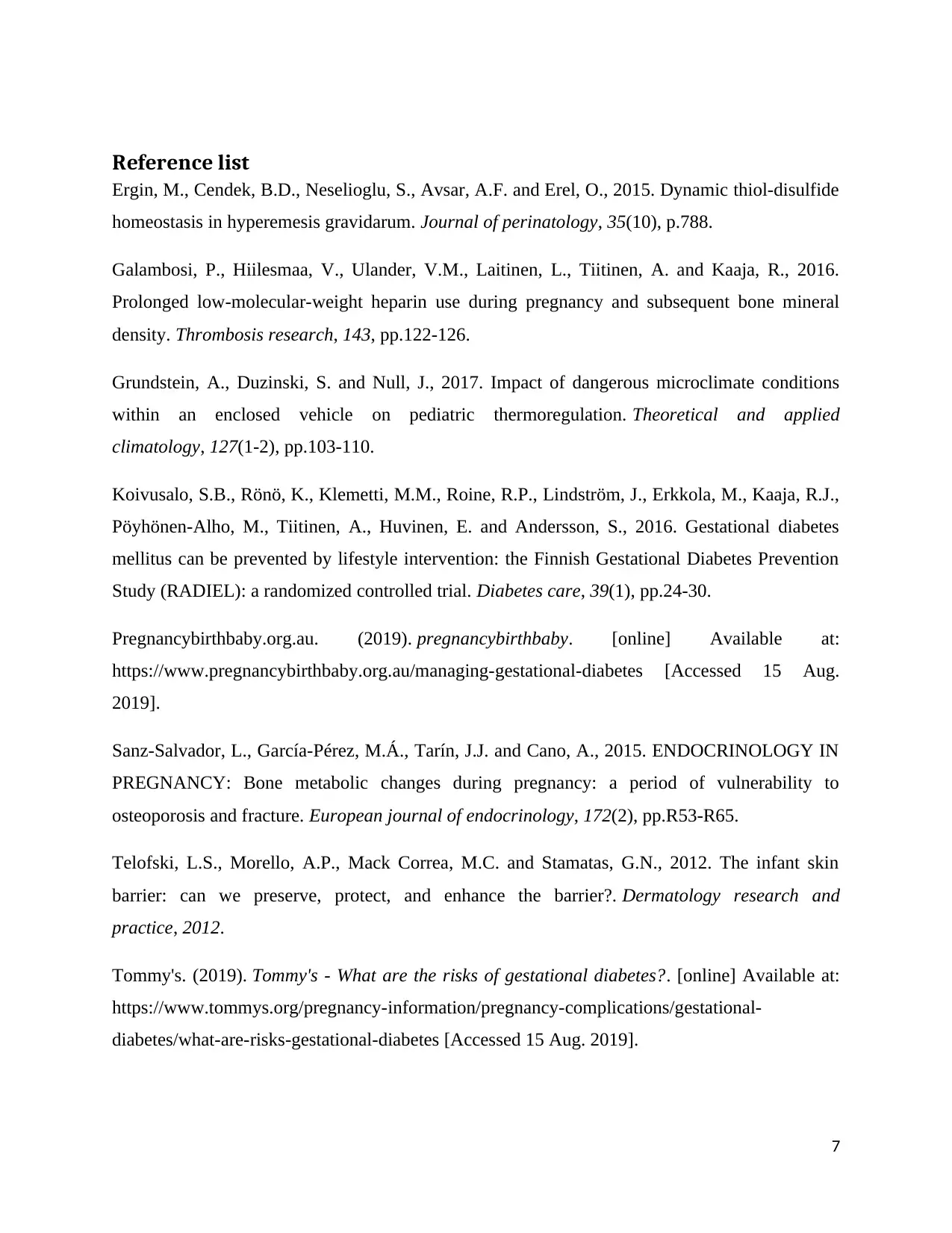
Reference list
Ergin, M., Cendek, B.D., Neselioglu, S., Avsar, A.F. and Erel, O., 2015. Dynamic thiol-disulfide
homeostasis in hyperemesis gravidarum. Journal of perinatology, 35(10), p.788.
Galambosi, P., Hiilesmaa, V., Ulander, V.M., Laitinen, L., Tiitinen, A. and Kaaja, R., 2016.
Prolonged low-molecular-weight heparin use during pregnancy and subsequent bone mineral
density. Thrombosis research, 143, pp.122-126.
Grundstein, A., Duzinski, S. and Null, J., 2017. Impact of dangerous microclimate conditions
within an enclosed vehicle on pediatric thermoregulation. Theoretical and applied
climatology, 127(1-2), pp.103-110.
Koivusalo, S.B., Rönö, K., Klemetti, M.M., Roine, R.P., Lindström, J., Erkkola, M., Kaaja, R.J.,
Pöyhönen-Alho, M., Tiitinen, A., Huvinen, E. and Andersson, S., 2016. Gestational diabetes
mellitus can be prevented by lifestyle intervention: the Finnish Gestational Diabetes Prevention
Study (RADIEL): a randomized controlled trial. Diabetes care, 39(1), pp.24-30.
Pregnancybirthbaby.org.au. (2019). pregnancybirthbaby. [online] Available at:
https://www.pregnancybirthbaby.org.au/managing-gestational-diabetes [Accessed 15 Aug.
2019].
Sanz-Salvador, L., García-Pérez, M.Á., Tarín, J.J. and Cano, A., 2015. ENDOCRINOLOGY IN
PREGNANCY: Bone metabolic changes during pregnancy: a period of vulnerability to
osteoporosis and fracture. European journal of endocrinology, 172(2), pp.R53-R65.
Telofski, L.S., Morello, A.P., Mack Correa, M.C. and Stamatas, G.N., 2012. The infant skin
barrier: can we preserve, protect, and enhance the barrier?. Dermatology research and
practice, 2012.
Tommy's. (2019). Tommy's - What are the risks of gestational diabetes?. [online] Available at:
https://www.tommys.org/pregnancy-information/pregnancy-complications/gestational-
diabetes/what-are-risks-gestational-diabetes [Accessed 15 Aug. 2019].
7
Ergin, M., Cendek, B.D., Neselioglu, S., Avsar, A.F. and Erel, O., 2015. Dynamic thiol-disulfide
homeostasis in hyperemesis gravidarum. Journal of perinatology, 35(10), p.788.
Galambosi, P., Hiilesmaa, V., Ulander, V.M., Laitinen, L., Tiitinen, A. and Kaaja, R., 2016.
Prolonged low-molecular-weight heparin use during pregnancy and subsequent bone mineral
density. Thrombosis research, 143, pp.122-126.
Grundstein, A., Duzinski, S. and Null, J., 2017. Impact of dangerous microclimate conditions
within an enclosed vehicle on pediatric thermoregulation. Theoretical and applied
climatology, 127(1-2), pp.103-110.
Koivusalo, S.B., Rönö, K., Klemetti, M.M., Roine, R.P., Lindström, J., Erkkola, M., Kaaja, R.J.,
Pöyhönen-Alho, M., Tiitinen, A., Huvinen, E. and Andersson, S., 2016. Gestational diabetes
mellitus can be prevented by lifestyle intervention: the Finnish Gestational Diabetes Prevention
Study (RADIEL): a randomized controlled trial. Diabetes care, 39(1), pp.24-30.
Pregnancybirthbaby.org.au. (2019). pregnancybirthbaby. [online] Available at:
https://www.pregnancybirthbaby.org.au/managing-gestational-diabetes [Accessed 15 Aug.
2019].
Sanz-Salvador, L., García-Pérez, M.Á., Tarín, J.J. and Cano, A., 2015. ENDOCRINOLOGY IN
PREGNANCY: Bone metabolic changes during pregnancy: a period of vulnerability to
osteoporosis and fracture. European journal of endocrinology, 172(2), pp.R53-R65.
Telofski, L.S., Morello, A.P., Mack Correa, M.C. and Stamatas, G.N., 2012. The infant skin
barrier: can we preserve, protect, and enhance the barrier?. Dermatology research and
practice, 2012.
Tommy's. (2019). Tommy's - What are the risks of gestational diabetes?. [online] Available at:
https://www.tommys.org/pregnancy-information/pregnancy-complications/gestational-
diabetes/what-are-risks-gestational-diabetes [Accessed 15 Aug. 2019].
7
1 out of 7
Your All-in-One AI-Powered Toolkit for Academic Success.
+13062052269
info@desklib.com
Available 24*7 on WhatsApp / Email
![[object Object]](/_next/static/media/star-bottom.7253800d.svg)
Unlock your academic potential
Copyright © 2020–2025 A2Z Services. All Rights Reserved. Developed and managed by ZUCOL.

